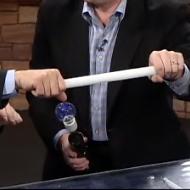Ordinary people use standard electricity from the wall to powera light. Oh, but not you! Why use normal electricity from the walloutlet when you can make your own? Get ready to amaze everyone withthis shocking display of science.
Human Conductor of Electricity
Ordinary people use standard electricity from the wall to power a light.

Here's What You'll Need
-
Fluorescent light
-
Balloon
-
Wool sweater
Experiment
- Darken the room. Hold the fluorescent bulb in one hand and the balloon in the other. Rub the balloon vigorously on your hair (or on a wool sweater).
- Bring the balloon near the bulb and watch what happens. Was that a flicker of light? Did the bulb really light up?
- Move the balloon up and down the bulb without touching the bulb. The light should sort of follow the balloon.
- Touch the balloon to the glass and see if you can get a spark to jump.
- You can't believe your eyes… so, go back to step 1 and do it again.
How Does It Work?
Electrons are relatively free to jump from one atom to the next, and they're attracted to some materials more than others. When you rub a balloon on your hair (or the sweater), electrons from your hair (or the sweater) jump over to the balloon and stay there. The inside of a fluorescent tube is coated with a white material made up of phosphors. If you bombard phosphors with ultraviolet light, they re-emit visible light. In normal operation, the fluorescent tube is connected to a source of electrical current. The current supplies electrons that slam around inside the tube. Inside the tube there is also mercury vapor. When electrons collide with the mercury vapor, they cause the vapor to emit ultraviolet light, which hits the phosphors and the tube lights up. Bringing a negatively charged balloon near a fluorescent tube stirs up the electrons in the mercury vapor. This produces an electrical current, which excites the mercury atoms. The excited mercury atoms emit ultraviolet light and cause the phosphors to glow. When a spark jumps, you get a big release of energy and a correspondingly brighter glow.
Additional Info
- Try the Static Powered Neon Light to demonstrate the power of static electricity.
- Use a Static Tube to uncover hidden static electricity.
- Charge a balloon and bring it close to a ping-pong ball. The ball will begin to move very slowly toward the balloon. Move the balloon around and the ball will follow.
- Charge a balloon and then blow soap bubbles. Bring the balloon close to the bubbles and they rise rapidly toward the balloon. Now you can tease the bubble around the room with the balloon.
- When you rub a balloon on someone's hair the balloon picks up electrons, leaving it negatively charged and the hair positively charged. Because opposite charges attract, bringing the balloon near the hair causes the hair to stand up.
- When you bring a charged balloon near pieces of paper, the paper isn't charged so you might expect nothing to happen. But the paper is attracted to the balloon. Why? The negative charge on the balloon repels the electrons in the paper, making them (on average) farther from the balloon's charge than are the positive charges in the paper. Because electrical forces decrease in strength with distance, the attraction between the negatives and positives is stronger than the repulsion between the negatives and negatives. This leads to an overall attraction. The paper is said to have an induced charge. This explanation applies to a charged balloon sticking to a wall and a charged balloon attracting other uncharged objects.
